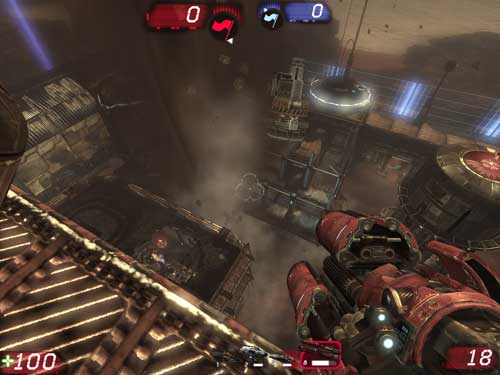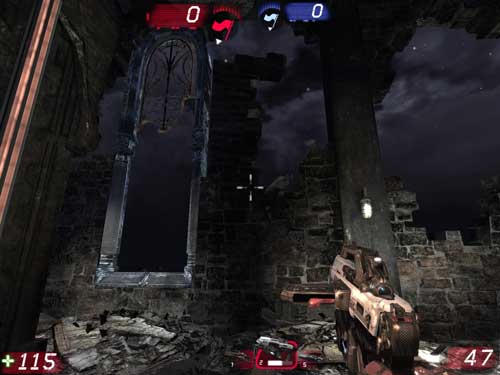PhysX’s Big Break? Unreal Tournament 3 PhysX Performance
by Ryan Smith on December 14, 2007 12:00 AM EST- Posted in
- GPUs
AGEIA’s Mod Pack & The Test
Unfortunately the PhysX situation in Unreal Tournament 3 is a little more convoluted than we would like. While the engine is capable of first-order physics using PhysX, because the game is not solely a technological showcase, there aren’t any maps that ship with it that heavily utilize physics interactions. The game does use the PhysX libraries to run some physical simulations, but other than a handful of situations such as cloth simulations, there isn’t much obvious physics work taking place. It’s not the eye-candy feasts that we’ve seen with other PhysX hardware enabled games, but this is also a benefit: UT3’s PhysX hardware support doesn’t enable any extra eye-candy, it solely offloads the physics work to the PPU. This will be an important distinction going forward as we’re going to be looking solely at issues of performance and not non-quantifiable (and performance-impairing) aspects of eye-candy.
AGEIA, apparently having taken charge of promoting PhysX on Unreal Engine 3, has been developing a mod kit to help modders/developers integrate physics situations in to their maps, and as a part of that kit has released a pair of maps that make heavy use of physical interactions as part of the gameplay. This makes UT3 straddle the line between being or not being a real/meaningful PhysX enabled game since as far as we know these are the only maps for the game that use first-order physics. This means that the biggest selling point for using a PhysX card with UT3 becomes the mod and not the game itself, but for the purpose of this article we’ll take the situation as it’s presented.
Along with our benchmarks of the shipping UT3 maps, we’ll include both of AGEIA’s mod maps in our benchmarks. The first map is CTF-Tornado, a map featuring a tornado that moves around unanchored objects, rips up some buildings, and sucks up unsuspecting players. As far as physical interactions goes this map is only moderately heavy, an intentional decision for allowing it to be playable without the PhysX PPU.
The second map is CTF-Lighthouse, AGEIA’s crown jewel out of their map pack, making very heavy use of physical interactions. This map features numerous destructible walls and floors, showcasing the direction AGEIA wants to push developers to go with physics. It’s also a pig of a map, as we’ll see it’s not playable at all without the PhysX PPU.
We’ve had to deviate a bit from our normal benchmarking routines, since UT3 does not support demo recording with AGEIA’s maps, presumably because of the first-order physics used. Instead we’ve gone with botmatches for all of our tests (including the normal UT3 maps) which offer variable results but also run the full client physics simulation process, ensuring that we’re capturing something fairly close to real world performance under repeatable circumstances. The use of bots means some CPU time is spent dealing with them, but given what we know about Unreal Tournament 2004’s player statistics, playing against bots turned out to be rather popular, so we don’t believe our results to be all that far fetched.
Every map we tested was run at 1600x1200 (our realistic scenario) and 800x600 (our anti-GPU bottlenecking scenario) both with the PhysX hardware enabled and disabled, on both a high-end QX6850 processor and a mid-range E6600. Varying all 3 processing components will allow us to reasonably isolate any bottlenecks in performance. All tests were run 3 times to reduce variability and the results averaged.
| Software Test Bed | |
| Processors | Intel Core 2 Quad QX6850 (3.00GHz/1333MHz) Intel Core 2 Duo E6600 (2.40GHz/1066MHz) |
| RAM | G.Skill DDR2-800 (2x2GB) |
| Motherboard | Gigabyte GA-P35-DR3R (Intel P35) |
| System Platform Drivers | Intel 8.1.1.1012 |
| Hard Drive | Maxtor MaXLine Pro 500GB SATA |
| Video Cards | 1 x GeForce 8800GTX |
| Video Drivers | NV ForceWare 169.12 |
| Power Supply | OCZ GameXStream 700W |
| Desktop Resolution | 1600x1200 |
| Operating Systems | Windows Vista Ultimate 64-Bit |












29 Comments
View All Comments
SignalPST - Friday, December 14, 2007 - link
On a unrelated note, does anyone know if the retail game shipped includes high resolution textures? People were complaining that the demo didn't include it, and the in-game graphics don't compare with anything like those eye-popping screenshots Epic teased us with.cubanx - Friday, December 14, 2007 - link
They are included but not the default. If you mess around with the settings you can get quality near the screen shots they released .Here's one tweak guide http://www.tweakguides.com/UT3_1.html">http://www.tweakguides.com/UT3_1.html
Dainas - Friday, December 14, 2007 - link
....And yet there still is NO PCIe PhysX card available for purchase.Heres another question for AGEIA; with dwindling PCI classic slots on todays motherboard, how do they expect people to use their products if there's no where to put it?
poohbear - Friday, December 14, 2007 - link
i hear u man. i have 1 soundcard and 1 wifi card and my other pci slot is blocked by the aftermarket cooler on my x1900xt, so there's simply no room for this card on pci even if i wanted to buy it.:pgoku - Monday, December 17, 2007 - link
get an ethernet to wifi converter, that way you can use the onboard ethernet on your motherboard.http://www.dslreports.com/shownews/Buffalo-Launche...">http://www.dslreports.com/shownews/Buff...Launches...
I'm sure there are others on the market as well.. I personally hate wifi and avoid it as much as possible. If I can get a wired connection, I'll use that first, even if it means running a line through the walls 50FT+ in order to get it.
SuperGee - Sunday, December 16, 2007 - link
That's choice there are more add-on's then ATX provide slot's for.This is not Ageia's problem. But more a choice the consumer must make.
Well I have a spare PCI slot next to my PPU. I realy don't have much in it a G-card and a PPU.
If for example choose for triple SLI you made a choice to blow away 3 to 9 slots.
Or must have a prof.RaidContoller and TV-card next to SLI. Then it get crowded with a soundcard..
And it not long ago that the populair sound card manufacturer offer a PCI-E sound card.
Mr Alpha - Friday, December 14, 2007 - link
I believe there is a PCIe x1 version of the PhysX card sold to OEMs. There was a story somewhere that said AGEIA was going to release the PhysX PCIe x1 card into retail, but decided not to when it turned out that it wouldn't work on a significant portion of the motherbaords with PCIe x1 slots, because the slots weren't implemented in accordance to PCIe specs. Something about out of spec jitter was mentioned.There is something Anandtech has been missing from their motherboard reviews: Do the PCIe x1 slots actually work?
PandaBear - Friday, December 14, 2007 - link
In Today's multi core CPU, unless you need to do physics with say 16 different threads, you would in theory ease 1 core out of all.Say the physics processor can do 1/2 of a CPU core's work (unlikely), then on a single core you gain 50% performance, dual core you gain 1/4, quad core 1/8.
Compare to how much of that work in theory could be done on a GPU (it's just math), and say it has the performance of 4 of the 48 shader's performance, you get 1/12 of a gain in GPU.
Now in practice, splitting work across a slow bus like PCIe, PCI, or HT are going to slow it down even more, with additional I/O work on both ends you are going to gain almost nothing (exactly where it is now).
I think if the market gets big enough, Nvidia or AMD will put one in their GPU, Intel/AMD will 1up each other by putting it in instead of wasting all the die space for cache. A dedicated physics processor on a bus as a card will never make it big.
Spoelie - Friday, December 14, 2007 - link
Your logic is completely flawed, since you do not know anything about the varying workloads, how good each type of chip is at each workload and how the workloads compare relatively.Specifically at physics calculation workloads, a PPU chip is a multitude of times faster than a cpu core. (Note the use of chip and core, since a ppu is more a collection of minicores). What this means is that when you peg one core of your multicore CPU at 100% load with solely physics threads, it is still way slower than a ppu, and thus can not handle the same physics workloads.
The actual performance boost is thus completely dependent on how big a workload the physics part of the application is. And current games do not have a big physics workload, partly because without a ppu the processing power is just not there.